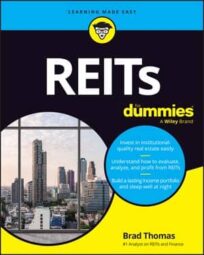REITs have stock attributes (liquidity and transparency) and, at the same time, enable you to enjoy the benefits of owning income-producing real estate. With this Cheat Sheet, you get a quick primer on the benefits of REIT investment, how to add REITs to your portfolio, how to choose smart REITs, and how to become a virtual landlord without the aggravation of owning private real estate.
Benefits of being a virtual landlord
Being an owner in a REIT (real estate stocks) can be an effective way to gain access to a proven income-oriented asset class — property ownership — but without the day-to-day headaches that can come from being a hands-on landlord.
By investing in REITs, you can effectively bypass all that by being a virtual landlord instead. Following, are several benefits of investing in REITs.
REITs invest in a wide range of property types
REITs invest in a wide range of property types. No matter where you’re headed locally (in the United States, at least), there’s a good chance you’ll find yourself in close proximity to a REIT–owned property.
That workplace, apartment building, grocery store, medical facility, hotel, or gym? They might be REIT-owned properties. By leasing out space and collecting rent on its real estate, REITs generate income that is then paid out to shareholders in the form of dividends.
REITs can have strong pricing power
As a REIT owner, you can take advantage of the pricing power that exists with income-producing real estate. REITs can capitalize on the demand for leasing space that exceeds new supply, which allows rents to grow. This supply-demand imbalance gives most REITs strong rental pricing power.
Net-lease REITs (REITs that own properties leased to single tenants under agreements in which the tenant pays for rent and some or all of operating expenses) are also attractive because of their long-term leases that generate durable cash flows in every economic climate.
As rents grow, dividends grow
Because REITs offer exceptional pricing power, they’re able to raise rents based on inflation, and they’re also well-prepared for high interest rates due to their efficient cost controls and balance sheet management practices.
REIT investment considerations
Because of the durable dividend income REITs provide, they can be an important investment both for retirement savers and for retirees who require a continuing income stream to meet their living expenses.
REIT dividends are driven by the steady stream of contractual rents paid by the tenants of their properties.
Other important attributes of owning REITs to consider include:
- Liquidity: REIT shares are traded on major stock exchanges.
- Transparency: REITs have independent directors, analysts, and auditors that provide oversight.
- Diversification: REITs offer access to the real estate market with low correlation with other stocks and bonds.
- Performance: REITs have provided long-term total returns like those of other stocks.
Choosing the best REITs
With over 890 listed REITs around the globe, where do you begin? The answer depends on your objective, and of course your own risk tolerance level.
The great thing about REITs is that you can be a landlord for practically every property category, all unique with their own demand drivers.
As you get started, here are a few guidelines worth considering:
-
Own more than one REIT or consider a REIT ETF. Diversification is important to the investing process, so when you start adding REITs to your portfolio, it’s important to spread your capital across multiple property sectors and geographies. In other words, don’t put all of your eggs in one basket.
Also, there are many different exchange-traded funds (ETFs), closed-end fund, and mutual fund alternatives that may be a good way to become a virtual landlord without having to do all the heavy lifting.
- Focus on quality. REITs come in many shapes and sizes, and it’s important to always look under the hood before buying. Spend time researching the underlying fundamentals to ensure that the dividend is safe and growing (on a frequent basis). High-quality REITs can expect to have good access to capital during most market cycles.
- Bet on the jockey. Most REITs are internally managed, which means you (the investor) are paying for the salaries of the management team. Always think of yourself as an owner and make sure (as the owner) your interests are aligned with management. Always maintain skepticism and in the words of Ronald Reagan, “trust but verify.”
- Don’t chase yield. By law, REITs pay out high dividends, but always remember that a double-digit dividend yield suggests limited growth prospects for the REIT. There’s nothing wrong with owning these higher-yielding stocks, but often these double-digit yields suggest a potential dividend cut.
- Buy low. Don’t overpay. Always make sure you’re getting value and buy REITs just like you would any other investment. Sometimes it takes patience, but over the long haul, your returns are magnified when you buy in at a cheaper price.

